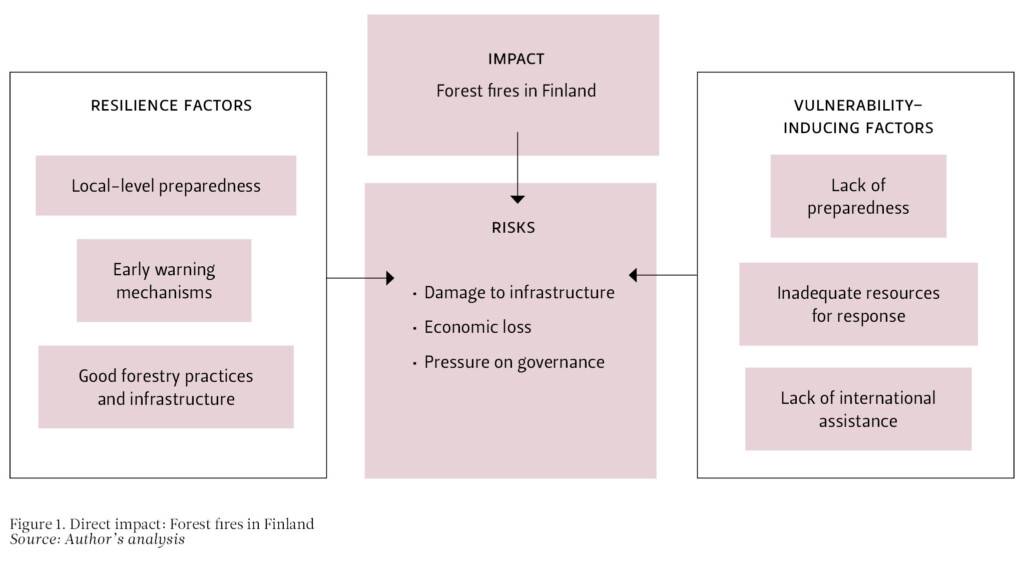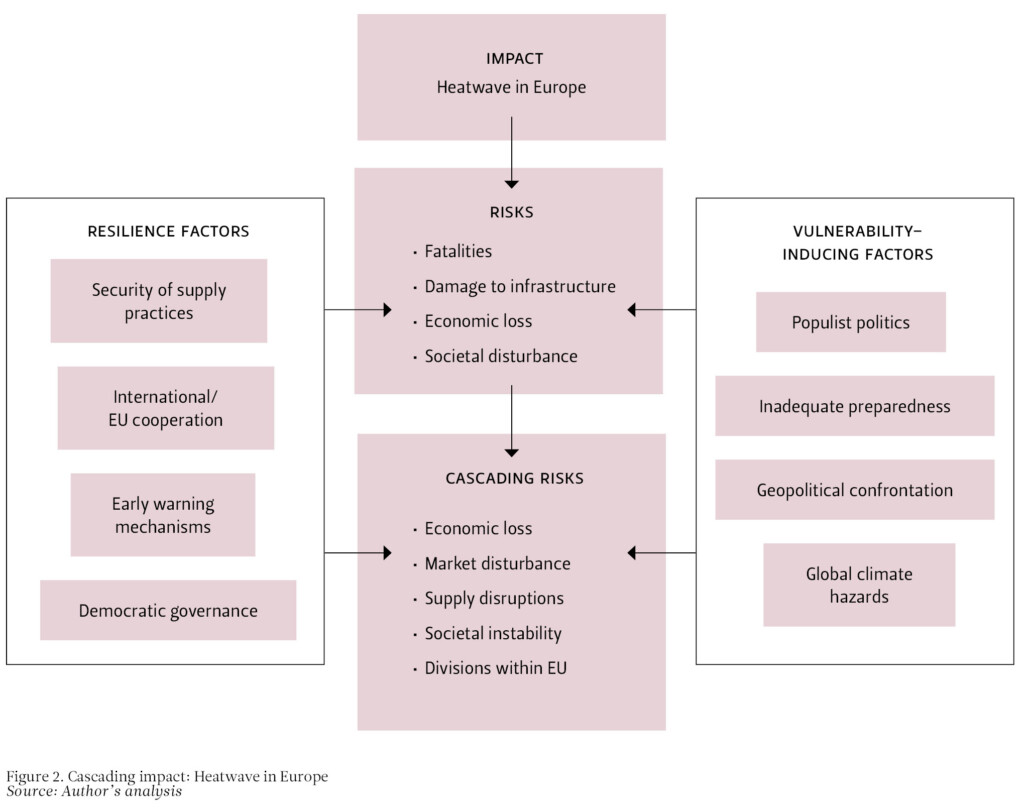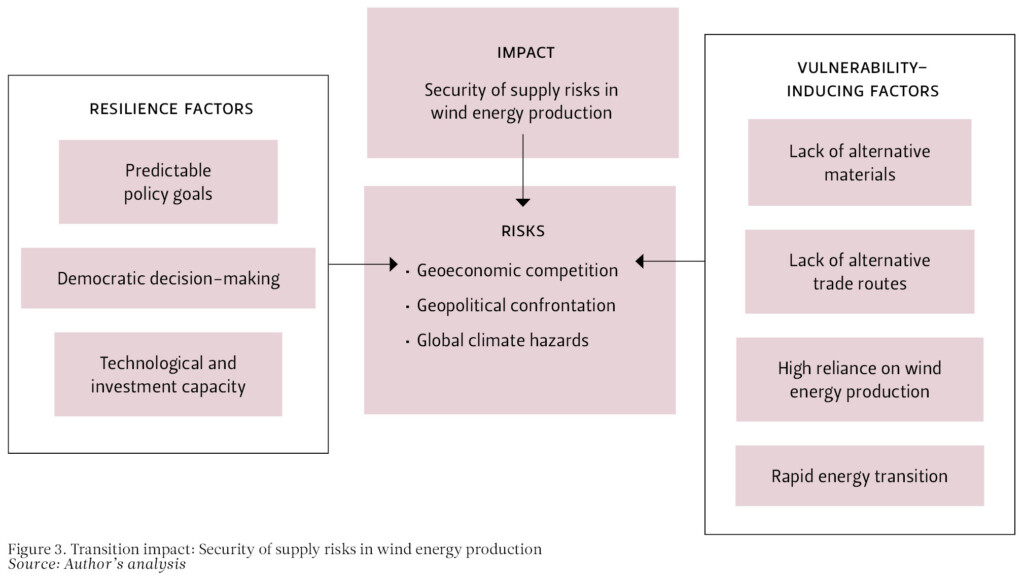yhteenveto
Ilmastonmuutoksen tuhoisat seuraukset ovat jo nähtävissä, ja tarve reagoida niihin käy yhä kiireellisemmäksi. Ilmastonmuutoksen vaikutuksia kokonaisturvallisuuteen ei kuitenkaan ymmärretä tarpeeksi hyvin.
Turvallisuusvaikutukset ovat monimutkaisia, sillä niillä on tapana ketjuuntua ja voimistaa toisiaan. Vaikutuksia on hankala käsittää kokonaisuudessaan, ja puutteellisen tilannekuvan seurauksena myös poliittiset päätökset jäävät todennäköisesti vajavaisiksi.
Tämän julkaisun tarkoituksena on lisätä ymmärrystä ilmastoturvallisuudesta antamalla konkreettisia esimerkkejä mahdollisista suorista, ketjuuntuvista ja siirtymävaikutuksista.
Ilmastonmuutoksen eri vaikutukset, kuten metsäpalot, Euroopan helleaallot tai tuulivoimatuotannon kasvu, aiheuttavat monenlaisia haasteita Suomen turvallisuudelle. Ne voivat esimerkiksi uhata terveyttä ja elinkeinoja, voimistaa yhteiskunnan polarisoitumista tai synnyttää uusia toimitusketjuriskejä.
Strateginen ennakointi, kansainvälinen yhteistyö ja hyvin suunniteltu ilmastopolitiikka voivat auttaa torjumaan ilmastonmuutokseen liittyviä riskejä.
Introduction
As the impacts of climate change are becoming more and more visible, the need to adapt and respond to them becomes increasingly urgent. Yet there is still a lack of nuanced understanding of the social, political and economic interactions through which climate change can impact security. Concrete examples of the pathways and chains of effects behind climate security impacts are crucial for developing effective preparedness measures. To move the discussion forward, this paper presents three examples of potential climate security impacts.
Climate change threatens people and societies around the world, and without decisive action its impacts will be aggravated in the future. Research shows that climate change imperils livelihoods, increases societal instability and conflict potential, disrupts global supply chains and escalates tensions in international relations. Mitigation efforts have remained slow and inadequate, to the extent that the vast and rapid actions needed now may generate new risks and vulnerabilities.[1]
This Briefing Paper focuses on Finland, which is an unconventional case as it is not highly vulnerable to direct climate impacts like floods or hurricanes. However, as a small country with an open economy, Finland is exposed to disruptions in global supply chains and networks. Likewise, climate policy in Finland is likely to have transboundary implications. The Finnish case can therefore provide helpful and widely applicable insights for tracing climate security impacts.
Although the examples presented here are realistic in the sense that they are based on projected impacts of climate change and developments that have already begun to take place, they are not prognoses of events that will inevitably occur. Instead, the examples provide scenarios of the kinds of impacts that are possible in the Finnish context, potentially to be used as a reference point in policy-oriented discussions. The specific impacts selected as examples illustrate the variety of consequences. Yet they are still limited in scope and present a relatively rough sketch of the pathways associated with the impacts.
The paper will first outline the concept of climate security and present a three-level framework to categorise the impacts. On the basis of this categorisation, the paper will then discuss three examples of climate security impacts relevant for Finland. Finally, the paper will conclude by proposing ways to move forward in improving climate security preparedness at both national and international levels.
Climate security: Concept and practice
Research on environmental and climate security dates back several decades. It covers a wide range of literature from statistical analyses studying the relationship between environmental factors and conflicts to case studies on the security impacts of environmental change on local communities. Despite a large body of evidence on the various interactions between climate and security, the implementation of policies and practices for increased preparedness has been slow.[2]
The sluggish implementation may be due in part to the complex character of climate security impacts, as they often take shape through chains of compounded effects.[3] In addition, many of the impacts of climate change are just starting to emerge, making it difficult to comprehend their full ramifications until they become more severe. In policy discussions, this leads to a lack of understanding of concrete impacts that would motivate action. In the absence of adequate situational awareness, policy responses are likely to fall short.
One way to tackle the disconnect between theory and practice has been to conceptualise climate change in a way that makes it possible to better discern the concrete implications. Hakala et al.[4] propose a division into three broad categories: direct impacts, cascading impacts and transition impacts.
Direct impacts entail changes in the physical environment and their consequences for human health and critical infrastructure. These include the human suffering and damage caused by extreme weather like storms, heatwaves and floods; slower onset developments like sea-level rise or aridity; as well as the ensuing consequences for infrastructure and vital societal functions. For example in 2021, severe storms and floods across Europe led to loss of life as well as grave infrastructure damage. Exposure and vulnerability play a significant role in determining the severity of direct impacts, so strong adaptation and preparedness capacity can reduce their repercussions.
Cascading impacts occur when environmental changes are combined with socio-economic and geopolitical factors, often forming complex chains of events that may cross national borders. For instance, extreme weather events near critical transportation choke points can cause supply chain disruptions. Long-term developments, like desertification and rising temperatures, drive forced migration.
Climate change does not have to be the main trigger behind cascading impacts. Recent events have shown how risks triggered by climate change cascade over national boundaries and are combined with the consequences of rising geopolitical tensions. For example, Russia’s war of aggression in Ukraine has sparked a food crisis that was aggravated by climate-related crop damage that has reduced the resilience of countries like Somalia in recent years.
Transition impacts result from the mitigation of and adaptation to climate change. These can occur due to harmful side effects of individual climate actions, such as cases where biofuel production has replaced food crops and led to land grabbing from small-scale farmers. Transition impacts are linked to the wider systemic disruptions stemming from decarbonisation. An example of this would be poorly planned climate policy measures driving up inequality, which would lead to increased societal polarisation.
The possibility of transition impacts does not mean that the mitigation of climate change should not move ahead. In fact, climate neutral societies are likely to be more secure than the present fossil-based ones. However, possible adverse impacts should be recognised in order to implement climate policy in a way that helps to avoid them.
As the categorisation shows, the causes and effects of climate-related security impacts tend to be cross-sectoral. This leaves foresight and preparedness activities with the difficult task of attempting to identify relevant risks and potential ramifications across several sectors of society. The following sections aim to address this by providing concrete examples of direct, cascading and transition impacts in the case of Finland.
Direct impact: Forest fires in Finland
As one of the most forested countries in Europe, Finland gains considerable economic, social and ecological value from its forests. So far, the country has not experienced major wildfires such as those in neighbouring Sweden in 2014 and 2018, but the risk of forest fires is projected to rise across Fennoscandia as a result of climate change.[5] The risk also largely depends on forest management and fire prevention practices, which have generally been considered successful in Finland in this regard. Yet the changing climate conditions challenge existing practices, and the risk of widespread fires cannot be ruled out.
In Sweden, efforts to tame forest fires tied up firefighting resources and other forms of emergency preparedness. In some cases, the fires directly threatened human lives. Smoke from the fires is also a health risk that causes respiratory and cardiometabolic symptoms – although this impact is particularly hard to quantify. In addition, the fires destroyed timber and land, causing significant economic losses.
Similar consequences are possible in Finland, as shown in Figure 1. The central role of forestry for the Finnish economy makes the potential economic damage all the more severe and raises the question of providing compensation for those affected. Forests have also been an important element of the Finnish carbon neutrality goal in the form of carbon storage and sinks, which widespread fires could heavily deplete.

Large and uncontrolled fires also pose a challenge for governance and leadership. Environmental disasters have not been a standard occurrence in Finland, so the authorities and especially the population do not have much experience in coping with them. Hence, decisive action must be taken to suppress the fires and address their consequences. Inadequate efforts during the emergency or its aftermath may easily lead to public outrage and erode trust in governance.
The experience of neighbouring countries underlines the increasing importance of fire prevention in Finnish forestry practices. Adequate training and resources of the emergency services must be maintained to reduce the implications of potential fires. Finland should also continue to cooperate with and contribute to the EU’s wildfire prevention and response activities, not only to gain expertise but to ensure that these services are functioning and have adequate resources in the future.
Cascading impact: Heatwave in Europe
In Finland, climate-related disasters are often perceived as distant and of limited consequence within Finnish borders. This view is mistaken as it ignores the cascading impacts stemming from climate events elsewhere – and neglects the severe hazards occurring nearby in Europe at an ever-increasing rate. Recent years have been marked by weather extremes like heatwaves and flooding, often with severe consequences such as heat-related deaths and disruptions to energy production. Research suggests that climate change has already increased the probability of such events and will continue to do so in the future.[6] A record-breaking heatwave in Europe is therefore a plausible future scenario.
In 2022, record heat caused widespread drought in continental Europe and wildfires in Spain, Romania, Portugal and France, for example. In addition to excess deaths and health problems, the heat caused economic losses, failed crops and disruptions to critical infrastructure, for example by hampering European energy production, which was already strained due to the consequences of Russia’s invasion of Ukraine. As rivers dried up, hydropower production was reduced, nuclear plants had to limit their output due to lack of cooling water, and coal transportation routes were hindered.[7]
Even if an extreme heatwave does not directly extend to Northern Europe, it will impact Finland. Disruptions in energy production will be reflected in the markets through rising prices, although Finland is relatively insulated against such consequences thanks to its high domestic output and the Nordic electricity market. Price increases tend to feed economic uncertainty, which can contribute to societal polarisation and discontent.[8]
Heatwaves hinder labour productivity in Europe, which together with droughts may affect agricultural and other imports. Combined with geopolitical crises or severe climate impacts elsewhere in the world, food security may also be affected in Finland. Heat-related disruptions to transportation routes may also affect the security of supply of various goods in Finland, driving up prices and causing short-term shortages.

Yet the main risks for Finland may well be at the political level. Without adequate mitigation, the impacts of advancing climate change are not equally distributed among all parts of Europe. Countries in the south will be disproportionately affected, with Spain, Portugal, Italy, Greece, Cyprus, Bulgaria and Romania exposed to worsening water stress and desertification in the coming decades. The growing scarcity of water and arable land hampers agriculture and other livelihoods and may fuel conflicts between different water user groups.[9] The unequal consequences need to be addressed at the EU level and may cause rifts between the more and less affected countries.
The countries hardest hit by extreme weather will need increasing support from the EU for emergency preparedness and compensation for economic losses. This may spark a broader political discussion about the need to balance long-term damage, such as the loss of livelihoods, especially in agriculture, or the need to build climate-proof infrastructure. Even if member states show solidarity, the creation of any binding mechanism is likely to cause contention, especially as costs are likely to be high.
Moreover, the damage is not only economic as deteriorating living conditions may force people to move from their homelands and give up livelihoods. Such losses are difficult to compensate, but inability to address them may feed discontent towards the EU and contribute to the popularity of Eurosceptic parties. Although the need for more effective climate action will grow, some of the policies needed may be considered harmful by the same actors who are most exposed to climate impacts. Coupled with general inflation, this can further feed political polarisation and confrontation.
The more divided the EU becomes, the more disadvantageous it will be for Finland. Particularly in a security situation that is likely to remain tense due to Russia’s war of aggression in Ukraine, European unity is a central element for Finland’s national security. Beyond that, growing division among member states hinders policymaking on crucial topics like the implementation of the European Green Deal. The political standstill could be amplified if more frequent environmental disasters force the EU into a constant crisis mode. Quarrels within the EU can also be channelled to the national level, fuelling extremist views and feeding political instability.
The cascading impacts of an event, such as a record heatwave in Europe, are difficult to prevent due to the various factors involved, which are shown in Figure 2. However, preparedness can be strengthened through a better shared understanding of the ways in which environmental factors influence society, the economy and politics. Meanwhile, international cooperation on climate security is indispensable, not least due to the transboundary character of the impacts.
Transition impact: Security of supply risks in wind energy production
The Finnish energy system is already advancing in its green transition, with wind energy production growing rapidly. Up by 41% from 2021 to 2022, wind energy now covers 14.1% of Finnish electricity consumption, and is expected to cover at least 28% by 2028.[10] Wind power is projected to become an ever more central element of electricity production as Finland aims to achieve its climate targets, including carbon neutrality, by 2035.
The crucial role of wind power is beneficial for Finland in various ways beyond climate action. It has contributed considerably to the relatively smooth decoupling from Russian energy and will support reaching self-sufficiency in electricity production. However, the growing share of wind power also means an increased dependency upon it, which generates new vulnerabilities that are important to identify in order to address them. This paper is limited to the example of supply chain risks, although other impacts are also possible, such as domestic land use disputes about wind energy production sites.
As global wind power production grows, the demand for wind turbine materials goes up. Wind energy production is more distributed than fossil-based alternatives and therefore requires more cable and converter stations. Although global mineral reserves may well be adequate to cover this enormous material demand in total,[11] the rapid pace of the development may cause shortages in the short term. Even a temporary lack of raw materials can cause unpredicted disruptions in the installation or replacement of wind power.
Material supply risks are aggravated by geopolitical factors. This is particularly the case for materials with limited availability, such as certain rare earth minerals like neodymium and dysprosium, which are currently mined and refined mainly in China. Dependence on a sole source of raw materials is risky, especially in a world of increasing geopolitical tensions and division. The current geoeconomic competition between the United States and China has already led both countries to block exports of specific critical technology or minerals, suggesting similar geopolitical moves may be made in the future. This could halt access to materials needed for wind turbine production.
Climate change can also further imperil the security of supply of critical materials. With production sometimes heavily concentrated on specific sites, a local environmental disaster like a flood or a storm can disrupt supply chains on a global scale, also affecting Finnish wind power expansion. At the same time, Finnish actors need to recognise that wind energy produced here poses risks to the environment at the source of the raw materials.
Transition impacts are similar to cascading ones in that they tend to involve interactions between multiple factors, as depicted in Figure 3. However, they generally originate from deliberate policies aimed at promoting the green transition, which presents an opportunity to anticipate and counteract some of the adverse consequences as a part of the policymaking process. This emphasises the importance of policy impact assessment, which should be an integral part of the governance of the green transition – and comprehensive enough to grasp at least some of its indirect implications. At the same time, foresight activities and anticipatory governance need to factor in climate policy objectives to genuinely reflect the societal, political and security implications of the transition.

Conclusions and the way ahead
The mitigation of climate change presents a massive task, made more difficult by the increasingly pressing need to adapt to its impacts. In the best case, improved preparedness will help mitigate climate change and adapt to the new situation. However, this requires determined action. It is possible to identify broader tenets of policymaking to enable climate security.
First, strategic foresight and anticipatory governance are increasingly important, and they need to factor in climate change and its mitigation. There is a growing need for climate expertise in foresight activities to enable it to become an integral part of scenario building and risk assessment. In this regard, Finland has an advantage due to its intricate model of comprehensive security, which already incorporates various sectors and actors. By further integrating climate change into this existing framework, Finland could be a pioneer in monitoring and assessing climate security impacts.
Second, there is a crucial international dimension to climate security. International cooperation on climate security can yield concrete modes of action, such as foresight tools for transboundary contexts. International mechanisms can also be an important resource for climate preparedness, for example by providing assistance for fighting forest fires. For Finland, a strong and integrated EU remains crucial for ensuring security, whether against climate change or other risks.
Third, it needs to be fully recognised that climate policy and the green transition are integral to security. As the energy crisis has shown, greener production can often help reduce harmful dependencies. At the same time, security policy needs to be informed of any emerging security impacts of sustainable technologies. Overall, well-planned, consistent climate policy is the best way to mitigate the risks of climate change while also avoiding measures that could feed inequality, discontent or social upheaval.
Endnotes
[1] IPCC (2021) “Climate Change 2021: The Physical Science Basis. Contribution of Working Group I to the Sixth Assessment Report of the Intergovernmental Panel on Climate Change”. Cambridge University Press. https://www.ipcc.ch/report/sixth-assessment-report-working-group-i/; Dalby, Simon (2020) Anthropocene Geopolitics: Globalization, Security, Sustainability. University of Ottawa Press; Hakala, Emma, Ville Lähde, Antti Majava, Tero Toivanen, Tere Vadén, Paavo Järvensivu and Jussi T. Eronen (2019) “Northern warning lights: Ambiguities of environmental security in Finland and Sweden”. Sustainability, 11(8), 2228.
[2] Hakala et al. (2019); Bremberg, Niklas, Malin Mobjörk and Florian Krampe (2022) “Global Reponses to Climate Security: Discourses, Institutions and Actions”. Journal of Peacebuilding & Development, 17(3). https://doi.org/10.1177/15423166221128180.
[3] Carter, Timothy R., Magnus Benzie, Emanuele Campiglio, Henrik Carlsen, Stefan Fronzek, Mikael Hildén, Christopher P.O. Reyer and Chris West (2021) “A conceptual framework for cross-border impacts of climate change”. Global Environmental Change, 69, 102307.
[4] Hakala, Emma, Sanna Erkamo, Juha Pyykönen, Heikki Tuomenvirta, Oras Tynkkynen, Kati Berninger and Antto Vihma (2021) “Climate change and Finnish comprehensive security: Insights into enhanced preparedness”. FIIA Briefing Paper 325, December 2021, The Finnish Institute of International Affairs. https://www.fiia.fi/wp-content/uploads/2021/11/bp325_emma-hakala-et-al_climate-change-and-finnish-comprehensive-security.pdf; building upon the categorisation in Hakala et al. (2019).
[5] Aalto, Juha and Ari Venäläinen (2021) “Climate change and forest management affect forest fire risk in Fennoscandia”. Research report, Finnish Meteorological Institute. https://helda.helsinki.fi/items/962003d1-c603-4361-8e31-56dac0e09c1a.
[6] WMO (2023) “State of the Climate in Europe 2022”. Report. https://public.wmo.int/en/our-mandate/climate/wmo-statement-state-of-global-climate/Europe-2022.
[7] Ibid.
[8] Pönkä, Harri (2022) “Energy prices to level off in 2023”. Debt Management Annual Review 2022. State Treasury. https://www.treasuryfinland.fi/annualreview2022/energy-prices-to-level-off-in-2023/.
[9] European Court of Auditors (2018) “Combating desertification in the EU: a growing threat in need of more action”. Special report 33. https://op.europa.eu/webpub/eca/special-reports/desertification-33-2018/en/index.html; Mathiesen, Karl, Kalina Oroschakoff, Giovanna Coi & Arnau Busquets Guàrdia (2021) “Droughts, fires and floods: How climate change will impact Europe”. Politico, 2 July 2021. https://www.politico.eu/article/how-climate-change-will-widen-european-divide-road-to-cop26/.
[10] Finnish Wind Power Association (2023) “Finnish wind power production increased by 41 percent in 2022”. Press release 3.1.2023. https://tuulivoimayhdistys.fi/en/ajankohtaista/press-releases/finnish-wind-power-production-increased-by-41-percent-in-2022.
[11] Månberger, André and Björn Stenqvist (2018) “Global metal flows in the renewable energy transition: Exploring the effects of substitutes, technological mix and development”. Energy Policy, 119, 226–241.

